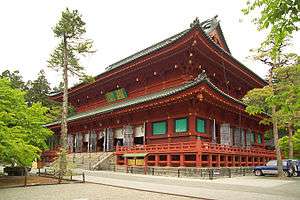Rinnō-ji
| Rinnō-ji 輪王寺 | |
|---|---|
 | |
| Basic information | |
| Location | 2300 Sannai, Nikkō, Tochigi Prefecture |
| Affiliation | Tendai |
| Deity |
Amida Nyorai (Amitābha), Senju Kannon (Sahasrabhuja Ārya Avalokitezvara), Batō Kannon (Hayagrīva) |
| Country | Japan |
| Website |
http://www.rinnoji.or.jp/ In Japanese |
| Architectural description | |
| Founder | Shōdō |
| Completed | 766 |

Rinnō-ji (輪王寺) is a complex of 15 Buddhist temple buildings in the city of Nikkō, Tochigi Prefecture, Japan. The site was established in the year 766 by the Buddhist monk, Shōdō. Due to its geographic isolation, deep in the mountains of Japan, the site soon attracted other Buddhist monks in search of solitude. Among the most famous buildings is the Sanbutsudō (三仏堂) or Three Buddha Hall. This building features gold-leafed statues of Amida, Kannon with a thousand arms (Senju-Kannon) and Kannon with a horse's head (Batō-Kannon). Next to the Sanbutsudō Hall there are Shōyō-en Garden and the Treasure House of Rinnō-ji.
Another building, near the mausoleum, houses an unusual statue of Amida riding a large crane, which is an iconography rarely found in Japan.
The temple also administers the Taiyū-in Reibyō (大猷院霊廟), which is the mausoleum of Tokugawa Iemitsu, the third Tokugawa shogun. Together with Nikkō Tōshō-gū and Futarasan Shrine, it forms the Shrines and Temples of Nikkō UNESCO World Heritage Site.
See also
- For an explanation of terms concerning Japanese Buddhism, Japanese Buddhist art, and Japanese Buddhist temple architecture, see the Glossary of Japanese Buddhism.
- List of National Treasures of Japan (shrines)
- List of National Treasures of Japan (writings)
External links
| Wikimedia Commons has media related to Rinnouji. |
- 日光山 輪王寺 公式ホームページ (in Japanese)
- Rinnoji Travel Guide
Coordinates: 36°45′14″N 139°36′11″E / 36.754°N 139.603°E
